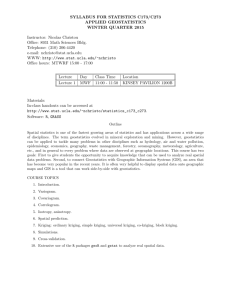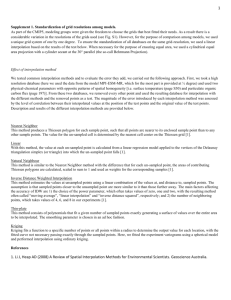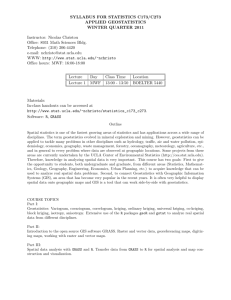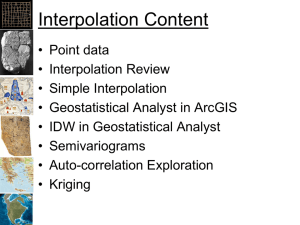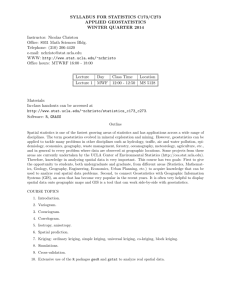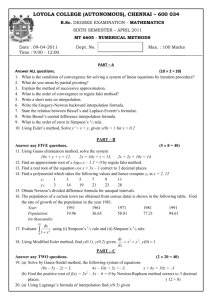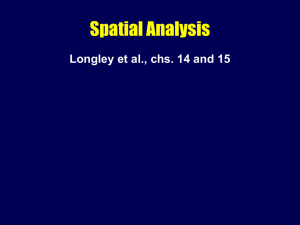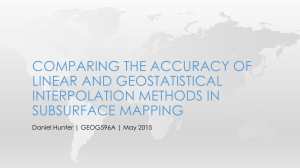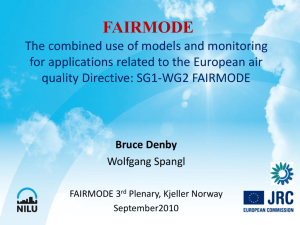Questions and Answers
advertisement
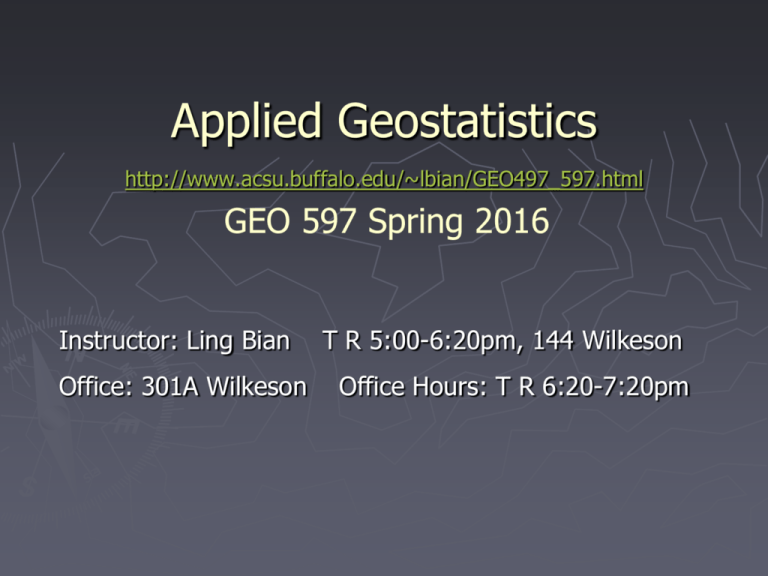
Applied Geostatistics http://www.acsu.buffalo.edu/~lbian/GEO497_597.html GEO 597 Spring 2016 Instructor: Ling Bian Office: 301A Wilkeson T R 5:00-6:20pm, 144 Wilkeson Office Hours: T R 6:20-7:20pm What is it ► The course is intended to introduce the basic concepts and applications of applied geostatistics, which address optimal spatial interpolation. What is it … ► Geostatistics are considered to be one of the most sophisticated spatial interpolation methods. The method is commonly used in many disciplines such as geology, engineering, hydrology, geography, ecology, urban studies, and medical geography. Geostatistics are closely related to statistics and GIS. What is it … ► Students with basic knowledge of statistics or GIS can take a step further to learn how to use geostatistics. The course emphasizes the applied side of geostatistics, and the method can be useful in students' immediate and future needs such as students' own theses and dissertations, or projects for their current or potential employers. What is it … ► The course uses a well received textbook for the lectures and a popular GIS software package ArcGIS for the lab exercises. Three lab sections and associated assignments will provide students with hands-on experience in using the geostatistical tool. Text ► An Introduction to Applied Geostatistics. Oxford University Press, New York, by Isaaks, Edward. H., and R. Mohan. Srivastava, 1989. ► The “Ed and Mo” book Prerequisites The course is open to graduate students who have knowledge of univariate statistics. ► Multivariate will help but is not required. ► Requirements ► ► During the semester, each student should apply the geostatistical interpolation to a data set. Past students’ projects Requirements ► A term paper ► Introduction Literature review Study area Data and methods (incorporate the labs, plus…) Results and discussion conclusions 10-15 double-spaced pages of text, plus tables, figures, references Grading Lab 1 10% Lab 2 10% Lab 3 10% Project Report 70% -------------------------------------------------------------Total 100% Grad cut-off A AB+ B BC+ C CD+ D F 93.33-100.0 90.00-93.32 86.67-89.99 83.33-86.66 80.00-83.32 76.67-79.99 73.33-76.66 70.00-73.32 66.67-69.99 60.00-60.66 <60 Tentative Schedule 1/26 1/28 2/02 2/04 2/09 2/11 2/16 2/18 2/23 Introduction Spatial Description Spatial Description Spatial Continuity Estimation Random Function Models Random Function Models Random Function Models Lab section 1 Tentative Schedule … 2/25 3/01 3/03 3/08 3/10 Global Estimation Point Estimation Ordinary Kriging Ordinary Kriging Block Kriging & Search Strategy 3/14-19 Spring Break Tentative Schedule … 3/22 Cross Validation 3/24 Modeling Sample Variogram 4/05 Modeling Sample Variogram 4/07 Lab Section 2 4/12 Lab Section 3 4/14 Co-Kriging 4/19 Co-Kriging 4/21,26,28, 5/3 Presentations 5/05 Conclusions Software ► ArcMap Geostatistics Analyst ► ESRI tutorial for Geostatistical Analyst 1. Definition ► A procedure of estimating the values of properties at un-sampled sites ► The property may be interval/ratio values, can be nominal and ordinal ► The rational behind is that points close together in space are more likely to have similar values than points far apart 2. Terminology ► Point/line/areal interpolation point - point, point - line, point - areal 2. Terminology … ► Global/local interpolation Global - apply a single function across the entire region Local - apply an algorithm to a small portion at a time 2. Terminology … ► Exact/approximate interpolation exact - honor the original points approximate - when uncertainty is involved in the data ► Gradual/abrupt 3. Interpolation - Linear ► Linear interpolation Known values Known and predicted values after interpolation 3. Interpolation - Linear Assume that changes between two locations are linear 3. Interpolation - Proximal ► Thiesson polygon approach ► Local, exact, abrupt ► ► Perpendicular bisector of a line connecting two points Best for nominal data Construction of Polygon + 130 + 200 + 150 + 180 + 130 Polygon of influence for x=180 Construction of Polygon.. + 130 + 200 + 150 + 180 + 130 Draw line segments between x and other points Construction of Polygon.. + 130 + 200 + 150 + 180 + 130 Find the midpoint and bisect the lines. Construction of Polygon.. + 130 + 200 + 150 + 180 + 130 Extend the bisecting lines till adjacent ones meet. Construction of Polygon.. + 130 + 200 + 150 + 180 + 130 Continue this process. 3. Interpolation - Proximal 3. Interpolation – Proximal .. ► http://gizmodo.com/5884464/ 3. Interpolation – B-spline ► Local, exact, gradual ► Pieces a series of smooth patches into a smooth surface that has continuous first and second derivatives ► Best for very smooth surfaces e.g. French curves 3. Interpolation – Trend Surface ► ► ► ► Trend surface - polynomial approach Global, approximate, gradual Linear (1st order): z = a0 + a1x + a2y Quadratic (2nd order): z = a0 + a1x + a2y + a3x2 + a4xy + a5y2 ► ► Cubic etc. Least square method Trends of one, two, and three independent variables for polynomial equations of the first, second, and third orders (after Harbaugh, 1964). 3. Interpolation – Inverse Distance ► Local, approximate, gradual S wiz i 1 z = --------, wi = -----, or wi = e S wi d ip -pd i etc. 3. Interp – Fourier Series Sine and cosine approach ► Global, approximate, gradual ► Overlay of a series of sine and cosine curves ► Best for data showing periodicity ► 3. Interp – Fourier Series 3. Interp – Fourier Series ► Fourier series Single harmonic in X1 direction Two harmonics in X1 direction Single harmonic in both X1 and X2 directions Two harmonics in both directions 3. Interp - Kriging Kriging - semivariogram approach, D.G. Krige ► Local, exact, gradual ► Spatial dependence (spatial autocorrelation) ► Regionalized variable theory, by Georges Matheron ► A situation between truly random and deterministic ► Stationary vs. non-stationary ► 3. Kriging First rule of geography: ► Everything is related to everything else. Closer things are more related than distant things ► By Waldo Tobler ► 3. Interp - Kriging ► Semivariogram ► Sill, range, nugget Semivariance 1 n g(h) = ------ S (Zi - Zi+h)2 2n i=1 Sill Range Lag distance (h) 3. Kriging Isotropy vs. anisotropy 4. Summary Statistics ► Parameters (for populations) m, s2, s ► Statistics (for samples), x, S2, S 4. Basic Statistics ► Measures of location mean, median, mode, minimum, maximum, lower and upper quartiles ► Measures of spread variance, standard deviation ► Correlation covariance, correlation coefficient

